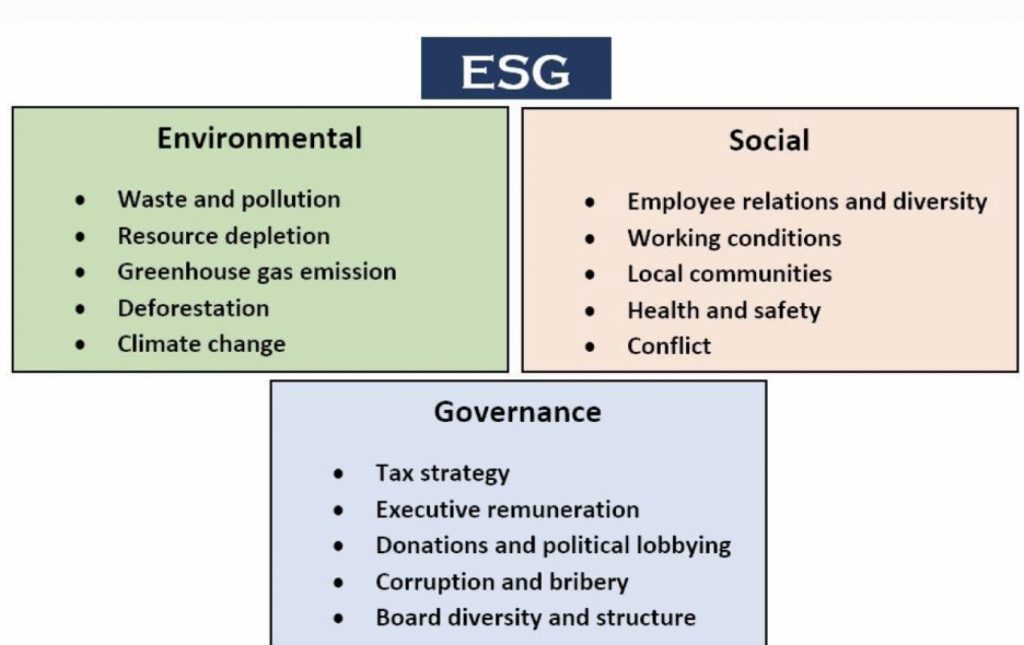In the world of commercial real estate, investing, and beyond, “Environmental Social and Governance” is becoming a frequent topic of discussion. But what exactly is ESG? Why is everyone talking about it? And what does it mean for your business? ESG stands for Environmental Social and Governance, and refers to the three key factors when measuring the sustainability and ethical impact of an investment in a business or company. More specifically, Environmental Social and Governance is a generic term often used in capital markets and is commonly practiced to evaluate the behavior of companies, as well as consider their future financial performance. We are seeing investors take social responsibility seriously by diligently researching companies’ ESG profiles and using Environmental Social and Governance criteria to screen potential investments. The graph above describes what falls under the ESG umbrella.
The percentage of global retail and institutional investors that apply these principles to a quarter or more of their portfolios jumped from 48% in 2017 to 75% in 2019, according to ALVA, the leading solution for reputation intelligence, analysis, and media monitoring. In 2018, sustainable investing assets totaled $14.1 trillion in Europe and $12 trillion in the United States. Additionally, Environmental Social and Governance assets in the U.S. are expected to reach $35 trillion by 2025. That growth shows just how important ESG practices are becoming in CRE, investing, and global business.
Considering the value and importance placed on sustainable investing, it is crucial to provide investors with accurate means to measure ESG performance and help identify Environmental Social and Governance risks when going through the investment process. The factors are a subset of non-financial performance markers, which include ethical, sustainable and corporate government issues. This includes creating systems to keep the company accountable and actively managing the company’s carbon footprint.
In September 2020, the World Economic Forum (WEF) released a set of ‘stakeholder capitalism metrics’, created to assist in the benchmarking of sustainable business performance. The metrics are centered on four pillars that encompass a variety of ESG factors:
- People: Diversity reporting, wage gaps, health, and safety.
- Planet: Greenhouse gas emissions, land protection, and water use.
- Prosperity: Employment and wealth generation, taxes paid, research and development expenses.
- Principles of governance: Purpose, strategy, and accountability informing risk and ethical behavior.
Here are some ways to incorporate and implement ESG practices at a company.
- Create programs dedicated to hiring a diverse range of employees.
- For example, ensuring that two-thirds of your newly hired employees are women and minorities.
- Making sure there is a healthy percentage of female directors/females in leadership roles.
- Consider turning down deals in areas that are prone to natural disasters.
- Diligently research every company you invest in.
- Does the company’s portfolio have ties to weapons, tobacco, etc.?
- What are issues the company is passionate about?
- Educate your employees on ESG practices and identify values or issues that are important to your company
Now that we understand ESG, the importance of, practices and small ways to begin implementing these values and practices at your company, we can fully acknowledge how investors are being more socially responsible, seeking out businesses with strong Environmental Social and Governance values, and how the success of companies is being measured. In part two we will be diving into more specific implementation and what Environmental Social and Governance practices to look for when investing in a company.
Coldwell Bankers Commercial, Agents are available to help you navigate commercial real estate within Billings, MT.








